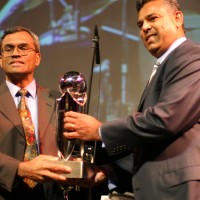by Glenn A. Baker
The Sri Lankans knew they had something beyond palm fringed beaches and misty tea plantations to command the attention of travellers; something concentrated in a burst of tightly packed splendour sufficient to dazzle even jaded senses.
They knew it in 1982 when a plan was drafted to tell the world all about it. But then came the inconvenience of a civil war waged by the Tamil Tigers which effectively severed the country from a lucrative tourist trail, dismantling its national carrier in the process.
The recovery was stymied again by the Boxing Day tsunami but now, a clear run of sunshine has enabled the teardrop shaped isle to finally focus international attention upon its Cultural Triangle, with a flow that has increased by a quarter in some years. All the planks are in place – an array of major airlines servicing the capital Colombo, all levels of efficient infrastructure and plentiful quality hotels ranging from boutique heritage bungalows to plush resorts.
One can certainly become enveloped in sites of Buddhist history in India, Nepal, Bhutan, Japan, Thailand, Cambodia, Indonesia, Tibet and China, but few of these enclaves can claim the intensity, the sheer convergence of the modern and the archaic, all tumbled one upon another like a huge theme park.
Stupas, sculptures, extraordinary architecture, monastic ruins, reservoirs and the thronged Full Moon festivals of Wesak and Poson, jungle-encased for more than a millennium, all evoking “the intense experience of ancient Buddhism” and its introduction to Sri Lanka.
The centrepiece of the triangle – which describes a loose construct formed by the Sinhalese civilisations of Kandy, Poloonaruwa and Anuradhapura – is the giant Sigiriya Rock fortress near the town of Dambulla in the Central Province, which is best viewed, for the sake of perspective, from the Aliya Resort and Spa, a hotel artfully put in place by Chandra Wickramasinge, one of the fathers of Sri Lankan tourism.
ooming as a massive 200-metre-high column over the flat plains, the rock commands all attention, with even the distance rendered insignificant by the otherworldly spectacle it provides.
It sits lordly and alone and one thinks inevitably of Australia’s Uluru. The one significant difference is that climbing to the top is not discouraged, indeed it is facilitated and encouraged.
Steps and ladders, taking you past chambers of frescoes and murals of celestial nymphs, massive rocks teetering on pivots that could be removed when enemies approached, a mirror wall, a mid-level Lions Gate with the beast – or at least its feet – reproduced on a terrace, and elaborate water gardens and royal palace on the roof to reward those who persevere with the ascent.
One climbs this citadel of the 5th century-built by King Kashyapa – a Sri Lankan UNESCO-listed World Heritage site, one of eight – because, as Hillary said of Everest, it is there. To pass it up, regardless of one’s physical state, seems alien to that which takes true travellers out of their front door.
The satisfaction derived from gazing out over the enchanted land below, scattered with historical edifices commanding your eventual presence, is giddying.
The descent, while swifter, has diversions difficult to ignore, such as an opportunistic cobra handler complete with the basket and flute, rock shelters and caves, and some labyrinthine pathways. The Sri Lankan government proudly bills it as the “8th Wonder of the World”, with fair justification.
Departing north from Kandy, the country’s second largest city and home of the beloved Temple of the Tooth, where it is possible (and indeed desirable) to stay at the Mountbatten Bungalows, the location of some of Lord Louis WWII strategies, one passes over the dry plains traditionally known as Rajarata – The King’s Land – into the very crucible of Sinhalese civilisation, marked at every turn by grandiose monuments, colossal meditating Buddhas, cave temples, exquisite paintings and stone carvings, families of monkeys loping into frame and cheerful cyclists pleased to be lost in the midst of it all.
The spiritual heart – like Borobudur in Java, Angkor in Cambodia and Pagan in Burma – is the great ruined city of Anuradhapura, the capital of the island from the third century BC until it was abandoned after an invasion in 993 AD. It is connected by a 13-kilometre pilgrim’s path to the mountain peak of Mihintale, long sought out by devotees as the place where the missionary monk Mahinda, son of Emperor Ashoka of India, met with King Devanampiyatissa and Buddhism took root. The monasteries, palaces and dagobas (dome-shaped shrines) which compete for all available land render this realm as important as the Egyptian pyramids.
As are the early 13th-century monuments of the “Sacred Quadrangle” at Polonnaruwa on Lake Topawewa, including a Thupurama stupa and a moonstone at the entrance of the Vatadage (relic house). Once enclosed by three concentric walls and dotted by gardens, this was the final flowering of Singhalese Buddhist art The grandeur lingers.
Spend enough time and the treasures of the Cultural Triangle will pile one atop the other until your eyes blur. Abandoned cities, temples, forest monasteries, national parks and Buddha statues are also to be found in Yapahuwa, Pandus Nuwara, Aluvihar, Ridi Vihara, Arankele, Ritigala, Minneriya, Wasgonmuwa, Kandulla, Aukana and Sasseruwa.
It helps to have a car and driver though local bus services reach into areas both local and remote. With a population just a tad under that of Australia and a remarkable amiability all around, poking around the place under one’s own steam can be both comfortable and rewarding.
If you stumble upon a night festival in the triangle, the numbers of praying and chanting participants, holding candles aloft, can be quite staggering. The Buddhist culture in this part of the world is animated and vivid.
Those who haven’t been overwhelmed by the ancient archaeology of it all tend to also seek out areas beyond this jammed region to remind themselves of the richness of an island where traces of human settlement range back over some 37,000 years, home to a royal dynasty which may be the longest in the world.
There is Galle Fort, a seaside town on the southwestern coastal belt. that was a Dutch stronghold before the British became dominant. The Central Highlands has the Peak Wilderness Sanctuary, Hortain Plains and Knuckles Range offering heritage up high.
Even during almost 30 years of civil war, which claimed up to 100,000 military and civilian lives, these sites of cultural significance and architectural splendour largely escaped damage, though there were some tragic exceptions. The Sacred Bo Tree in Anuradhapura, the world’s oldest living tree, grown from a sapling planted in 249 BC that had been taken from a tree in India where the Buddha is said to have gained enlightenment, was attacked in 1985 by LTTE separatists who gunned down 146 civilians.
For visitors to the Tamil city of Jaffna, which has been returned to travel itineraries in recent years, one needs to stumble over the rubble of the Royal Palace – though that destruction began in the days of the Portuguese occupation. Not every visitor to Sri Lanka arrives intent upon cultural enrichment.
Those Indian Ocean-encased beaches – notably Passekudah Bay and its Maalu Maalu Resort, Bentota, Marble Beach and Arugam Bay on the East Coast; Mirissa, Unawatuna, Uppivelli and Hikkaduwa on the South Coast; Nogombo, Kalutara, Beruwla and Bentoa on the West Coast, offer what is often touted as the “best in Asia” – clean, largely uncrowded, quality surfing, scuba and snorkelling. And for every visitor who shells out for a T-shirt – every single one of them bearing an elephant in one form or another – the pachyderm parades are as prevalent as tea pickers.
There is an elephant orphanage at Pinnawalla and the Elephant Freedom Project near Kandy but the opportunity exists to witness them in the wild at four National Parks – Kaudulla, Minneriya, Udawalawe and Yala. With visits to the former able to be arranged as jeep safaris from Polonnaruwa, Dambulla and Sigiriya Rock in the Cultural Triangle, the intertwining of historical and natural Sri Lanka makes eminent sense. Throw in a side trip to a beach and a romp through a plantation and it all comes together perfectly.











![TV-Poster-All-Exhibition-Sri-Lanka-in-Focus-USA-2025[1]](https://www.srilankafoundation.org/wp-content/uploads/2025/04/TV-Poster-All-Exhibition-Sri-Lanka-in-Focus-USA-20251-450x450.jpg)










